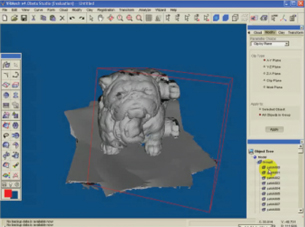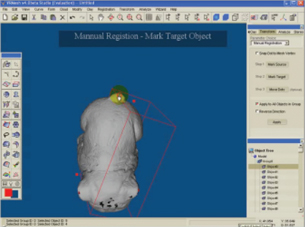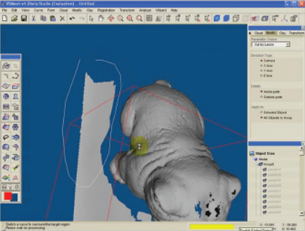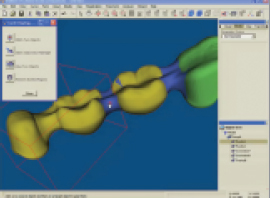VRMesh Is Like Digital Glue
Version 4 packs engineering, communication, and inspection tools into one reasonable package.
April 1, 2008
By Mike Hudspeth
 Figure 1: This little dog statue was scanned from different angles to capture all the details.That resulted in multiple overlapping point clouds that you are going to have to make sense of. Notice the extra feetgrowing out of the side and the second scowling mouth. |
OK, here’s the deal. You’ve got little or no time to come up with a design that needs to match or interface with something that already exists. In fact, the object was made several hundred years ago by some Renaissance guy in funny pantaloons. What do you do? Well, the first thing that you would want to do is get a 3D scan of the object. That will net you point cloud information. But what if you can’t — the budget won’t support a trip out to the location. What if all you have is a photo? Are you sunk? Not if you have a tool like VRMesh.
VRMesh, from VirtualGrid of Seattle, WA, is really a family of products that make it fairly easy to work with 3D scanner information and photographs. You can even model with it directly! VRMesh Design lets you bring in and repair STL files and do conceptual design. VRMesh Reverse is for reverse engineering just about anything. And VRMesh Studio is for those who need engineering tools as well as communications in one package.
 Figure 2: There are very few 3D scanners that can capture an entire object all in one pass. That meansyou are left with multiple point clouds that must be joined together. In VRMesh all you need to do isidentify points that are common to each point set and the software will join them up. |
What’s Going On?
VRMesh works by doing something called Mesh Modeling. In a nutshell, that’s where you take a point set and sort of triangulate it. That is, you connect the dots. And you end up with a meshed surface. You can think of the end product as something like an STL or VRML file. It’s made up of all these facets. How accurate it is depends on how small your tolerance is set. Obviously it’s interpolating between the points, and the more points the more accurate it is.
VRMesh Studio will take in 3D point cloud data from just about any scanning device that puts out ASCII format. Once in, you can have VRMesh Studio automatically convert the cloud to a mesh with just one click. Of course, not every 3D scan comes in perfectly. Most have little errors (noise, missing information, etc.) that make the scan difficult to work with. Most often you have multiple scans that, when put together, describe the entire object (see Figure 1). You then take all that data to make a watertight body out of it. How? Well, first you must triangulate and clean the point clouds. Then, you need to register them. This means you identify common points on the meshes that you want to match up (see Figure 2). Do you remember those great pictures on the back cover of MAD magazine? If you folded the back cover just so, both points met and a picture emerged. This process is kind of like that. Once everything is registered, VRMesh Studio can simplify and merge e verything into one object.
 Figure 3: In any 3D scan, there are usually things that need to be fixed. In VRMesh you select what youdon’t want and delete it. You can also fill in those pesky holes. |
At this point, you can edit and repair anything in the mesh that isn’t right. Say for instance you find some little holes and extra stuff like the floor the object was standing on (see Figure 3). You can fill them in and smooth them over by editing the edges of adjacent triangles. To eliminate extra geometry you just select and delete it. For bigger holes you can create your own patches and match the curvature of surrounding geometry. If there are bumps on the surface where there shouldn’t be you can just eliminate them. It’s sort of like using sandpaper. You just tell VRMesh Studio where to smooth and it will. Almost always you have a few normals that are pointing in the wrong direction. (Normally, normals point away from the center of mass of your model/object.) You can edit these directly and avoid twisting and self-intersecting surfaces. You can add fillets, trim or extend edges. You can even offset meshes to whatever thickness you want, w herever you want. It doesn’t all have to be the same. And if that’s not enough, you can glue meshes together (see Figure 4). Working with VRMesh is like modeling with digital clay. You can push and pull to make new or edit existing features. Of course, you can sweep and revolve sketched curves as well.
 Figure 4: To make one unified model out ofseveral you need the digital equivalent of glue.Fortunately,VRMesh is up to the task. |
You can also use VRMesh as an inspection tool. It will allow you to generate color-coded images that really point out any variances. When you find something, you can then create dynamic references for others to see and evaluate. You can export the images to programs like Microsoft Word and Excel to flow into reports. You can measure things like point-to-point distances or the angle between two vectors. VRMesh will also let you create cross-sections in any number you want.
The system requirements for VRMesh are about standard for technical software nowadays. Windows is a must as well as a pretty nice processor (1.8-2.6GHz recommended). You’ll need a lot of RAM (512MB-2GB), but what doesn’t? You also need 2GB of free hard drive space — whatever happened to programs that prided themselves on how little space they required?
Oh yeah, you’ll want a graphics card that supports OpenGL. There is a ton of import/export formats. Interestingly, a good number of them aren’t even 3D but are 2D bitmap. You’ve got the familiar standbys: .stl, .dxf, and .obj.
VirtualGrid is a fairly new company on the 3D scene but they seem to be off to a good start. While you might say that there are other software packages out there that do all the things VRMesh does, I don’t think you’ll find them in the same price range. For more information on the VRMesh family of products (like a more specific list of what each member will and won’t do), you can find out everything on VirtualGrid’s website.
More Info:
VRMesh 4
VirtualGrid
Seattle, WA
vrmesh.com
VRMesh Studio; $895/$399 educational
VRMesh Reverse; $695/$299 educational
VRMesh Design; $495/$199 educational
Mike Hudspeth is a senior designer for a global medical company and has been using a wide range of CAD products for more than 20 years. He, his wife, two daughters, and their cats live outside of St. Louis, MO.
Subscribe to our FREE magazine, FREE email newsletters or both!






